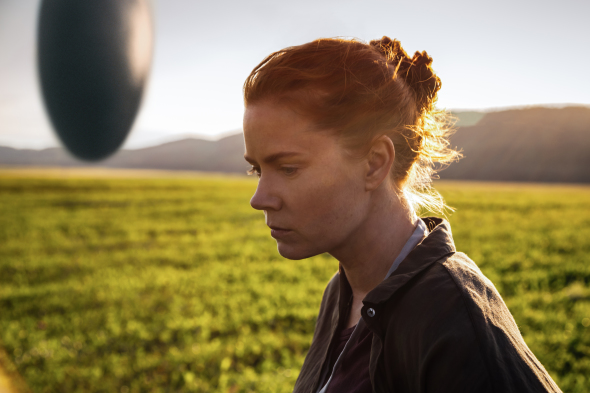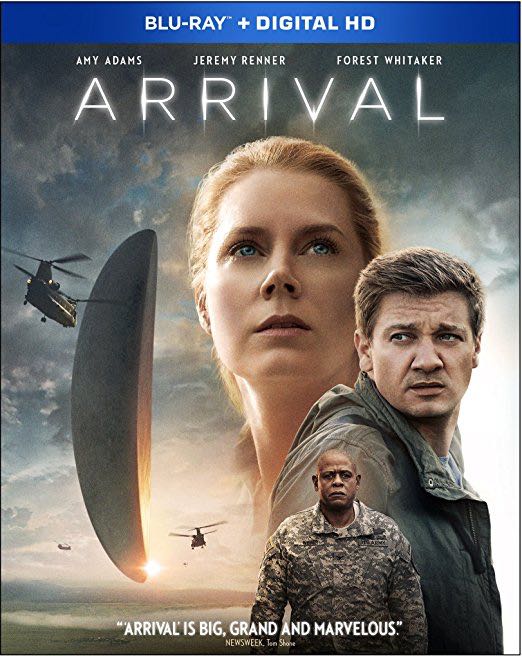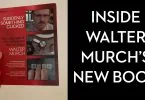The Making of Arrival
If, like me, you thoroughly enjoyed Denis Villeneuve’s masterful Arrival, then you’ll probably appreciate these excellent interviews (mostly with Editor Joe Walker), VFX breakdowns and other behind the scenes goodies, to expand your understanding of the film.
These interviews are packed with spoilers so if you’ve not seen the film you can pre-order it here, when it comes out on Valentine’s Day 2017 (February 14th).
If you enjoy this post might want to check out the previous ‘Making of’ posts including:
If you haven’t heard of Denis Villeneuve before, he’s the director of Prisoners and Sicario and the up-coming Blade Runner 2049.
Post Perspective’s Iain Blair has a nice interview with Villeneuve which has some interesting insights on the post and VFX process and working with editor Joe Walker.
Do you like the post process?
I absolutely love post and editing — so much so that if I wasn’t a director I’d be an editor.It’s insane the amount of creativity you have in post, and you don’t have to deal with all the problems with weather and actors and equipment and time and money. You can just focus on the creative part of actually making the film, so I love post.
The sound design and original score in Arrival is pretty unique and according to Villeneuve it was the product of a close collaboration between himself, editor Joe Walker and composer Johann Johannson.
In this episode of Song Exploder from Hrishikesh Hirwayin which Johann breaks down a track from the score called “Heptapod B”. It’s fascinating to hear Johann’s creative process and the layering of the instruments and recording techniques. Well worth a listen!
Joe Walker on Editing Arrival
UPDATE – Joe Walker in Conversation with ACE
In this new video from American Cinema Editors (A.C.E.) Glen Garland interviews Joe on the process of cutting Arrival. This video is part of their Oscar nominee series.
We work without temp tracks… to make sure it’s the story that’s driving the pace of the film, it’s not John Williams. The big side benefit is that the composer has a blank canvas to work with and secondly you end up giving opportunity to sound design, or in the case of Arrival there’s some wonderful moments of total silence.
The always excellent DP/30 has a ‘super-sized’ chat with editor Joe Walker for an hour.
They cover a lot of interesting ground and numerous films like Bladerunner 2049, Sicario and Arrival. There’s plenty of insights that you don’t get in other interviews with Joe, that make this an excellent listen!
We both love cutting with the speakers off, which is just something we started doing on Sicario, and cutting it as a silent movie sometimes… but it seems to be a good approach with his films, that if it works with just the visuals and you can tell what’s going on and the story is working… it makes you very tough [on the story].
Of all the video interviews in this post, this is probably ‘the best’.
For Oscar nominated editor, Joe Walker Arrival marks his second collaboration with director Denis Villeneuve. Check out this previous post which is packed with interviews with Joe focusing on Sicario.
This live-stream recording from Gold Derby editor Zach Laws is an enlightening watch.
In the following interviews you can learn a lot about Joe’s process of editing the film over 8 months, but the first article you absolutely MUST read is from Joe himself.
Moviemaker Magazine has a brilliant article from Joe on how to edit yourself out of a corner, which delivers some essential advice for editors of all experience levels.
The editor’s greatest superpower is playing with time: speeding things up or slowing them down to examine a moment in microscopic detail. This simulates our experience of life—the altered sense of time when a car lurches without warning across the lanes ahead.
“Pace” isn’t just rattling through a film without allowing anyone to feel anything; you have to add variety and landscape the moments you want to dwell on. A director I worked with used to say, “You’ve got to sell some to buy others.” Apply firm scrutiny of the sense of time throughout the story.
I have a trick for this: When the film’s in good shape and you’re nearly finished, write scene numbers on a slip of paper and pull each randomly from a hat. Then, look at that scene—only that scene.
Maybe investigate the dailies one more time. Is it the best it can be?
Toward the end of movies there tend to be scenes that don’t get as much of a workout as those up top. This prevents that carelessness. Economise. Use cuts as sparely as you can.
Don’t tire everyone out telling them what to think all the time. Allow the audience to invest their attention in a character or a shot.
The whole article is absolutely fantastic and well worth taking the time to properly digest.
Steve Hullfish’s excellent series Art of The Cut, delivers another fine interview with Joe, which features this great screengrab of his Avid Media Composer timeline of the final cut of reel 5 of 6.
Here are some interesting details that emerge during a discussion on bin layouts, memorising dailies and refining the edit – plus working on Blade Runner 2049 and Roger Deakin’s wife!
On Blade Runner I’ve been enjoying the luxury of screening dailies with James Deakins every day, which has been amazing. James – despite her masculine name – is DP Roger Deakin’s wife AND the digital dailies workflow consultant.
Especially when a scene is divided over several days so I don’t start panicking that something isn’t covered – James can just tell me it’s already planned for the next day. On every movie, I try and watch everything and I try and remember it all…
The truth is I’ll get to material by jumping out of the assembly with a matchframe and pop out to the original and then work my way round to neighboring takes. So where the takes are in the bin is perhaps not the most important thing for me.
You know I think all of us have a little OCD in us and that seems to be an essential element in wanting to put all these tiny fragments together into some cohesive shape. We are effectively Lego addicts at some point.
As always Steve’s interviews and detailed treasure troves of insights and enjoyable reading for any editor interested in improving their grasp of the craft.
[soundcloud url=”https://api.soundcloud.com/tracks/294474853″ params=”auto_play=false&hide_related=false&show_comments=true&show_user=true&show_reposts=false&visual=true” width=”100%” height=”450″ iframe=”true” /]In this episode of AOTG’s Cutting Room interview series, Gordon Burkell interviews Joe for a second time (check out his previous interview on Sicario, here) on playing with time, working with music and much more.
I come from a music background, I was a composer and I’m very nervous about over-reliance on temp tracks. I think they are unfair to composers because they tie their hands behind their backs before they’ve had a chance to respond to a tabula rasa, and also it means in sound terms, it prohibits the investigation of silence and the investigation of sound effects, so I like, if possible, to do things with an atmosphere or a mood, or in Twelve Years a Slave, cicadas, for example.
You can check out the full transcript here and more interviews from the ATOG SoundCloud channel.
Studio Daily’s interview with Joe brings out some other interesting insights which compliment the other interviews in this post.
Did you use any software or other tools in your suite differently while assembling this film?
For sure. In terms of the Avid, I was using all 24 video tracks for the first time in my life. We were stacking up versions and there were lots of little refinements to be made all the time in order to achieve what Denis was after.
Another way technology really helped me this time around was with the heptapod oral language. I wanted to get the alien language developed really early.
The minute we arrived in Montreal at the beginning of the shoot I was telling Denis about District 9, which has such lovely bug language in it. So we hired Michelle Child and Dave Whitehead, a couple who do this in New Zealand. They’re the experts and we hired them really early on.
It was helpful for a number of reasons. One, it helped dictate to a degree the pace of the scenes with the heptapods to allow enough time for things to happen. I didn’t want to rush those scenes. They were very delicate, and it’s a very big build to the point where you meet them. We are literally slowing time down in those moments to try to capture that dread and dislocation and build it with music. Then, when you get there, we tried to convey this idea with the rhythm of things that humans and heptapods are far adrift; it’s not question and answer, it’s more overlapping.

To round out this collection of interviews with Joe is this interesting post on Awards Daily which is part of their ‘Through the Lens’ series. In it Joe talks about three specific scenes in the film and the creative process involved in each.
People don’t notice this but we had this amazing aerial shot of the incredible mist coming from the hills. People assume that there was CGI in that shot, but that mist was God’s own visual effects.
They had two days. One was flat and boring. The next day, we had sunkissed mist floating down. We had other CGI to blend in with it because it was a short-lived weather event.
I held it for a long time to let people see it. It was a great first view. We built up to that. There are the news reports where you glimpse this thing. We took amazing footage in Venezuela and fed it.
The choice was to starve everybody of what they wanted to see. So, when you see it, you really give it to them. It’s bold. I thought it was a ballsy approach to deal with the exposition of this thing.
Colour Grading Arrival

Studio Daily has a great interview with colorist Joe Gawler on his collaborative work on the colour grade for Arrival.
Working with Denis [Villeneuve], Bradford [Young] and Joe Walker, a tremendously talented editor who was also involved in the color grade, was one of the most wonderful collaborative projects I’ve been involved with.
Denis is the final voice as the director, but he was respectful of all of us. Of course, some projects are more collaborative than others. Sometimes you’re just pushing buttons for someone else, but this was everyone bringing something creative to the table.
The interview dives into some specific aspects of the colour grade including the enhancement of the texture within the images, with some great details.
It goes back to Bradford’s aesthetic — he’s showing you just enough so there’s some mystery there as well. You’re not quite sure what you’re looking at, because the underexposure keeps you guessing to a certain point.
With Bradford’s style of shooting, there’ not a lot of wiggle room [in the DI]. He bakes it in. What we’re doing is nuanced work on top of a perfectly exposed, elegant image.
Can you give an example of those nuances?
Certainly at the entry into the ship, there’s a lot of windowing and shaping of the corners of the frame to keep it mysterious. So much of that sequence had CG elements, so we had to help pull them into the more underlit, mysterious world and the parts that were more practically shot.
So in the entrance to the ship, we’re pulling down the corners of the frame, and when you’re looking down to the outside of the ship, we had to drive the exterior up so it was a strong, almost blinding contrast. We spent a lot of time there, and we spent more time on some of the CG elements than we did some of the practically shot footage.
The whole interview is well worth a read!
Arrival VFX Breakdowns
In this VFX breakdown from Montreal based, Oblique FX you can get a good look at that first sighting shot Joe mentioned (above) as well as the various set extensions, CG additions and spaceships they seamlessly incorporated into the film.
If you want more insights into the VFX work that you may (or may not) have noticed on in the film, Art of VFX has an really good interview with Production VFX Supervisor Louis Morin on his work on Arrival.
What was his approach and expectations about the visual effects?
He wanted the VFX to be ordinary, not flashy nothing to do with an Hollywood VFX driven movie. He said “more like a grey day of February in Montreal”. Photorealism, grittiness with also the help of Bradford Yound (ASC) that’s what Denis got for his film.How did you simulate the aliens presence and interactions on-set?
We did previz and we had puppeteers on set with long poles and a sphere at the end of it. They add precise directives of speed, movement and heights to match the aliens. Denis was directing the aliens through a microphone and the spheres were mainly there for the eye-line and interactions.

VFX house Hydride (a division of Ubisoft) were responsible for all 245 of the shots involving the aliens on screen presence, as well as designing and developing their visual language.
Hybride artists were also responsible for the “logograms”—the written language used by the aliens as they attempt to communicate with the humans. Working with concept art supplied by the production team, Hybride artists took over the development of the transition effects, delivering a total of 70 logogram shots for the film. Other VFX by Hybride include look development and animation for the fog, where realistic interaction with the aliens was critical.






